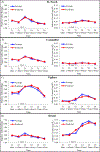Within-person patterns of psychobiological stress response correspondence: links to preadolescent internalizing problems and coping behaviors
- PMID: 34632877
- PMCID: PMC8994789
- DOI: 10.1080/10615806.2021.1982912
Within-person patterns of psychobiological stress response correspondence: links to preadolescent internalizing problems and coping behaviors
Abstract
Though correspondence across the affective experience and physiologic arousal levels of the stress response is thought to support efficacious coping and buffer against internalizing problems, little evidence has demonstrated such correspondence. Using a community sample of preadolescents (N=151, Mage=10.33 years, Minage=8.92, Maxage=12.00, 51.7% male), this person-centered study examined internalizing problem and coping-linked variability in psychobiological stress response correspondence. Preadolescents were exposed to the Trier Social Stress Test and self-reported negative affect (NA) and salivary cortisol (SC) levels were assessed. Multitrajectory modeling revealed four subgroups. Relative to In-Touch (i.e., Moderate NA-Moderate SC; n=65), Unmindful (i.e., Moderate NA-Low SC; n=49) were more likely to present with parent-reported but not self-reported internalizing problems; Vigilant (i.e., High NA-Low SC; n=13) were more likely to present with self- and parent-reported internalizing problems, less likely to use engagement coping, and more likely to use wishful thinking (e.g., "I wish problems would just go away."); Denial (i.e., Low NA-High SC; n=24) self-reported similarly low internalizing problems, but were also more likely to report reliance on denial (e.g., "I pretend problems don't exist."). Findings illustrate meaningful heterogeneity in preadolescent psychobiological correspondence with implications for multimodal assessment and outcome monitoring in coping-based preventative interventions.
Keywords: Cortisol; adolescent; coping; internalizing problems; negative affect.
Conflict of interest statement
Figures
Similar articles
-
Adolescent stress experience-expression-physiology correspondence: Links to depression, self-injurious thoughts and behaviors, and frontolimbic neural circuity.J Affect Disord. 2022 Mar 1;300:269-279. doi: 10.1016/j.jad.2021.12.098. Epub 2021 Dec 24. J Affect Disord. 2022. PMID: 34954334 Free PMC article.
-
Person-centered examination of salivary cortisol and alpha-amylase responses to psychosocial stress: Links to preadolescent behavioral functioning and coping.Biol Psychol. 2018 Feb;132:143-153. doi: 10.1016/j.biopsycho.2017.11.011. Epub 2017 Dec 15. Biol Psychol. 2018. PMID: 29248565 Free PMC article.
-
Adolescent girls' stress responses as prospective predictors of self-injurious thoughts and behaviors: A person-centered, multilevel study.Dev Psychopathol. 2022 Oct;34(4):1447-1467. doi: 10.1017/S0954579420002229. Epub 2021 Mar 25. Dev Psychopathol. 2022. PMID: 33762041 Free PMC article.
-
Adolescent cortisol and DHEA responses to stress as prospective predictors of emotional and behavioral difficulties: A person-centered approach.Psychoneuroendocrinology. 2021 Oct;132:105365. doi: 10.1016/j.psyneuen.2021.105365. Epub 2021 Jul 26. Psychoneuroendocrinology. 2021. PMID: 34399100 Free PMC article.
-
If the coping fits, use it: Preadolescent recent stress exposure differentially predicts post-TSST salivary cortisol recovery.Dev Psychobiol. 2017 Nov;59(7):848-862. doi: 10.1002/dev.21542. Epub 2017 Jul 25. Dev Psychobiol. 2017. PMID: 28742218
Cited by
-
Adolescent stress experience-expression-physiology correspondence: Links to depression, self-injurious thoughts and behaviors, and frontolimbic neural circuity.J Affect Disord. 2022 Mar 1;300:269-279. doi: 10.1016/j.jad.2021.12.098. Epub 2021 Dec 24. J Affect Disord. 2022. PMID: 34954334 Free PMC article.
References
Publication types
MeSH terms
Grants and funding
LinkOut - more resources
Full Text Sources

